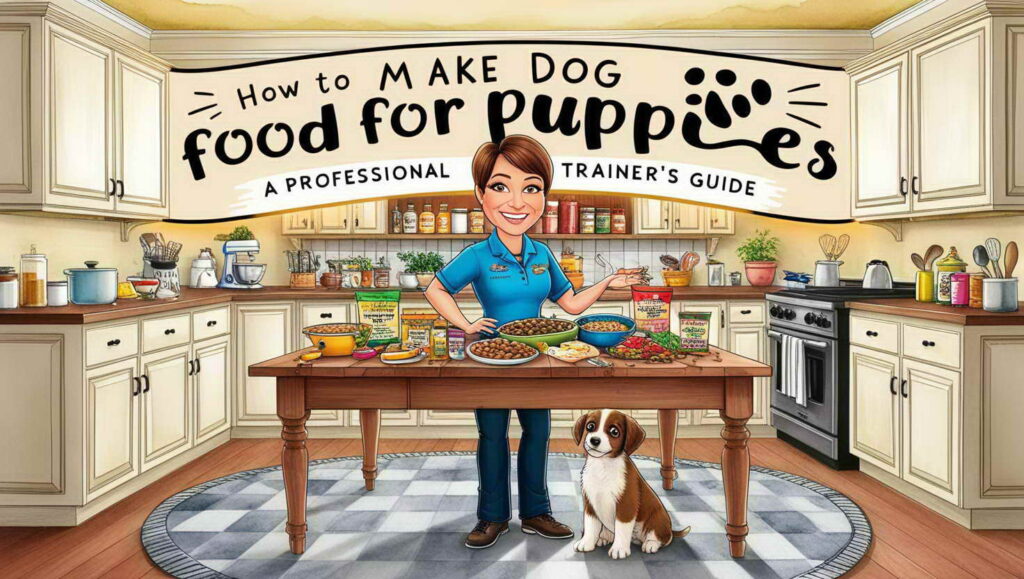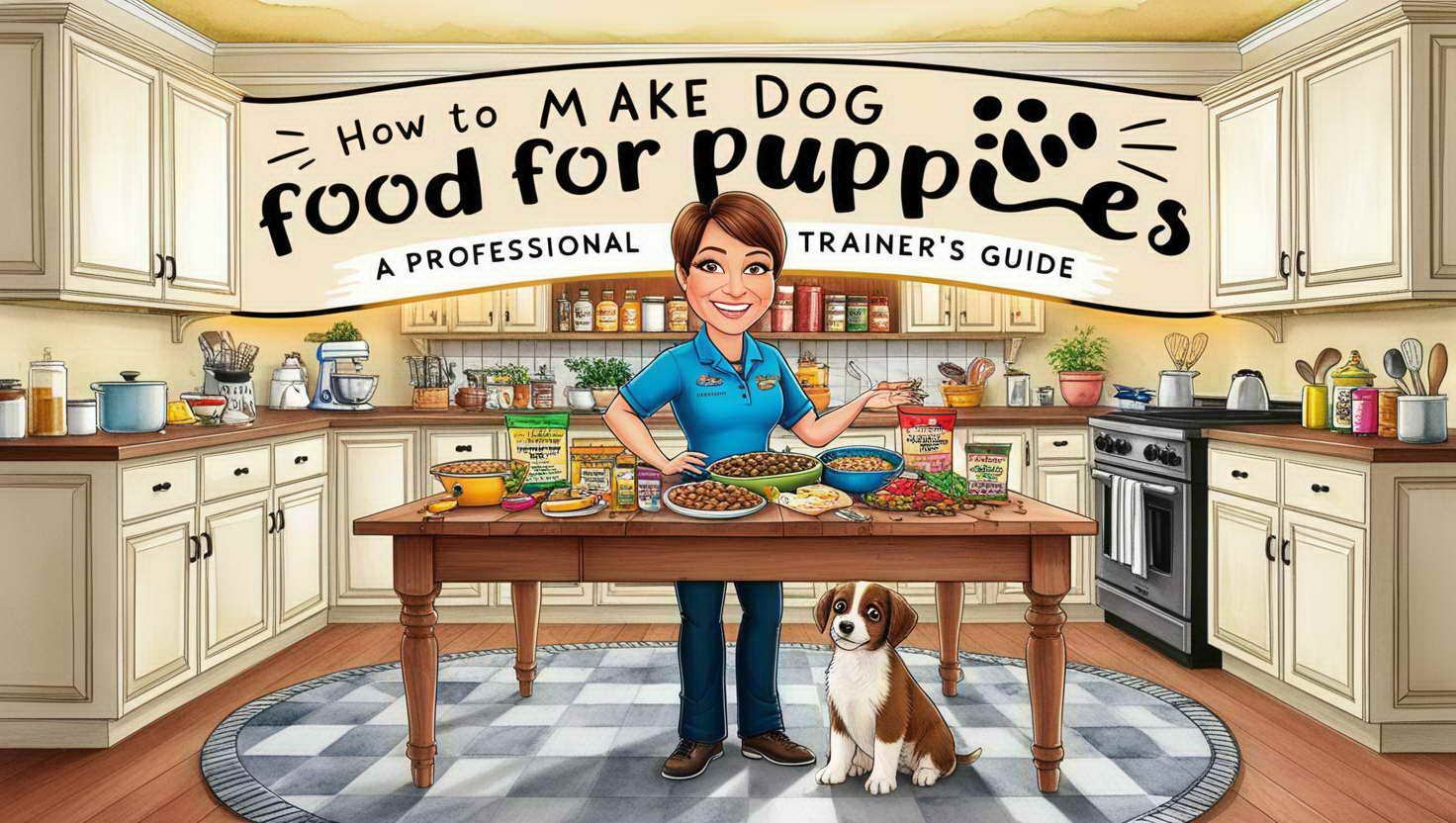
How To Make Dog Food For Puppies: A Tail-Wagging Guide
Hey there, fellow dog lover! I’ve seen firsthand how important proper nutrition is for puppies. Today, I’m going to share my knowledge on making homemade dog food for your little furball. It’s easier than you might think, and it can be a great way to ensure your pup gets the best start in life.
Why Make Your Own Puppy Food?
Before we dive into the nitty-gritty, let’s talk about why you might want to make your own puppy food:
- Control over ingredients: You know exactly what’s going into your puppy’s food.
- Freshness: Homemade food doesn’t sit on shelves for months.
- Customization: You can tailor the diet to your puppy’s specific needs.
- Bonding: Preparing food for your pup can be a great bonding experience.
Now, let’s get into the details!
Understanding Your Puppy’s Nutritional Needs
First things first, puppies have different nutritional requirements than adult dogs. They need:
- More calories: Puppies burn through energy like there’s no tomorrow!
- Higher protein: For all that growing they’re doing.
- Balanced calcium and phosphorus: Essential for proper bone development.
- DHA: An omega-3 fatty acid crucial for brain and eye development.
Essential Ingredients for Homemade Puppy Food
Here’s a list of ingredients you’ll want to include in your homemade puppy food:
- Protein sources:
- Lean meats (chicken, turkey, lean beef)
- Fish (salmon, sardines)
- Eggs
- Carbohydrates:
- Brown rice
- Sweet potatoes
- Pumpkin
- Oatmeal
- Vegetables:
- Carrots
- Green beans
- Peas
- Spinach
- Fruits (in moderation):
- Blueberries
- Apples (no seeds)
- Bananas
- Healthy fats:
- Fish oil
- Flaxseed oil
- Coconut oil
- Supplements:
- Calcium (if not using bone meal)
- Multivitamin formulated for puppies
A Basic Puppy Food Recipe
Alright, let’s get cooking! Here’s a basic recipe you can start with:
Ingredients:
- 1 pound lean ground turkey
- 1 cup cooked brown rice
- 1/2 cup cooked and mashed sweet potato
- 1/4 cup finely chopped or pureed vegetables (carrots, green beans, peas)
- 1 tablespoon fish oil
- 1 teaspoon calcium powder (or finely ground eggshells)
- 1 multivitamin tablet, crushed
Instructions:
- Cook the ground turkey in a large skillet over medium heat until fully cooked. Drain any excess fat.
- In a large bowl, combine the cooked turkey with the cooked brown rice and mashed sweet potato.
- Add the chopped vegetables, fish oil, calcium powder, and crushed multivitamin.
- Mix all ingredients thoroughly.
- Let the mixture cool before serving.
This recipe will make about 4-5 days worth of food for a medium-sized puppy. Remember to adjust portions based on your puppy’s size and energy level.
Feeding Guidelines
Now that you’ve got your homemade puppy food ready, let’s talk about how to feed it:
- Portion sizes: Puppies typically need 2-3 times the amount of food per pound of body weight compared to adult dogs. Consult with your vet for specific recommendations.
- Feeding frequency:
- 6-12 weeks old: 4 meals per day
- 3-6 months old: 3 meals per day
- 6-12 months old: 2 meals per day
- Consistency: Keep the food consistency similar to canned puppy food – not too chunky, not too soupy.
- Temperature: Serve the food at room temperature or slightly warm.
- Fresh water: Always provide fresh, clean water alongside meals.
Tips for Success
Here are some pro tips to help you succeed in your homemade puppy food journey:
- Gradual transition: If you’re switching from commercial food, do it gradually over 7-10 days to avoid tummy upset.
- Variety is key: Don’t stick to just one recipe. Rotate proteins and veggies to ensure a balanced diet.
- Prep in bulk: Make large batches and freeze portions for convenience.
- Monitor weight: Keep an eye on your puppy’s weight and adjust portions as needed.
- Consult your vet: Always consult with your veterinarian before making significant changes to your puppy’s diet.
Common Mistakes to Avoid
Even with the best intentions, it’s easy to make mistakes when preparing homemade puppy food. Here are some common pitfalls to watch out for:
- Unbalanced nutrition: Puppies need a carefully balanced diet. Don’t just throw together whatever you have in the fridge.
- Overfeeding: It’s easy to overfeed when you’re making food from scratch. Stick to recommended portions.
- Inadequate calcium: Growing puppies need the right amount of calcium. Don’t skip the calcium supplement unless you’re using bone meal.
- Using unsafe ingredients: Some human foods are toxic to dogs. Avoid onions, garlic, grapes, raisins, chocolate, and xylitol.
- Lack of variety: Don’t stick to one recipe forever. Variety ensures a range of nutrients.
- Ignoring special needs: Some puppies may have allergies or sensitivities. Pay attention to how your pup reacts to different ingredients.
Advanced Tips for Homemade Puppy Food
Once you’ve got the basics down, you might want to explore some more advanced techniques:
Batch Cooking and Storage
- Weekly prep: Set aside time each week to prepare your puppy’s meals in bulk.
- Proper storage: Divide the food into portion-sized containers and refrigerate (use within 3-4 days) or freeze (use within 2-3 months).
- Thawing safely: Thaw frozen portions in the refrigerator overnight, never at room temperature.
Adding Variety to Your Puppy’s Diet
- Rotate proteins: Switch between turkey, chicken, beef, and fish to provide a range of amino acids.
- Seasonal vegetables: Use what’s in season for maximum nutrition and cost-effectiveness.
- Bone broth: Make a nutritious bone broth to use as a base for your puppy’s meals.
Tailoring Recipes for Special Needs
- Allergies: If your puppy shows signs of food allergies, work with your vet to identify problem ingredients and find suitable alternatives.
- Weight management: For puppies that need to gain or lose weight, adjust the ratio of protein to carbs in their food.
- Sensitive stomachs: For puppies with sensitive digestions, try easily digestible proteins like chicken or fish, and mild vegetables like pumpkin or sweet potato.
The Raw Debate: Dog Food Raw Meat
When discussing how to make dog food for puppies, we can’t ignore the topic of raw meat. The raw food diet, often called BARF (Biologically Appropriate Raw Food), has gained popularity in recent years. Some pet owners swear by feeding raw meat to their puppies, claiming benefits like improved digestion, healthier coats, and cleaner teeth. However, it’s a controversial topic in the veterinary world. While raw meat can provide high-quality protein, it also carries risks of bacterial contamination like Salmonella or E. coli. If you’re considering incorporating raw meat into your puppy’s diet, it’s crucial to source it from reputable suppliers and handle it with extreme care to prevent foodborne illnesses. Always consult with your vet before introducing raw meat, as puppies have delicate digestive systems and may be more susceptible to infections. Remember, whether you choose to include raw meat or not, the goal is to provide a balanced, nutritious diet that supports your puppy’s growth and development.
The Importance of Monitoring and Adjusting
Making your own puppy food isn’t a set-it-and-forget-it process. It’s crucial to monitor your puppy’s health and adjust the diet as needed:
- Regular weigh-ins: Check your puppy’s weight weekly to ensure they’re growing at a healthy rate.
- Coat condition: A shiny, healthy coat is a good indicator of proper nutrition.
- Energy levels: Your puppy should be energetic and playful. Low energy could indicate nutritional deficiencies.
- Stool quality: Firm, well-formed stools are a sign of good digestion.
- Vet check-ups: Regular vet visits can help catch any nutritional issues early.
The Role of Treats in Your Puppy’s Diet
While we’re focused on meals, let’s not forget about treats! Treats are great for training, but they should be factored into your puppy’s overall diet:
- 90/10 rule: Treats should make up no more than 10% of your puppy’s daily calorie intake.
- Healthy options: Consider using small pieces of cooked chicken or tiny bits of carrot as treats.
- Homemade treats: You can make healthy treats at home using ingredients like pumpkin, banana, or sweet potato.
- Training sessions: Use meal times for training by using pieces of their regular food as rewards.
Transitioning to Adult Food
As your puppy grows, you’ll eventually need to transition them to adult dog food. This typically happens around 1 year of age for most breeds, or up to 2 years for large and giant breeds. Here’s how to make the switch:
- Gradual transition: Over the course of 7-10 days, gradually increase the proportion of adult food while decreasing puppy food.
- Adjust ingredients: Adult dogs need less protein and calories than puppies, so you’ll need to adjust your homemade recipe accordingly.
- Consult your vet: Your vet can help you determine the right time to switch based on your dog’s breed, size, and individual development.
Final Thoughts
Making your own puppy food can be a rewarding experience for both you and your furry friend. It allows you to have complete control over what goes into your puppy’s body during this crucial growth period. However, it’s also a big responsibility. Always do your research, consult with professionals, and pay close attention to your puppy’s health and development.
Remember, every puppy is unique. What works for one might not work for another, so be prepared to adjust and experiment (safely, of course) to find what works best for your little buddy.
Lastly, don’t forget that making homemade food is just one aspect of raising a happy, healthy puppy. Regular exercise, training, socialization, and lots of love are all equally important!
So, are you ready to don that chef’s hat and whip up some puppy-approved meals? Your furry friend’s tail will be wagging in no time! Happy cooking, and give your pup a belly rub from me!

Leave a Reply